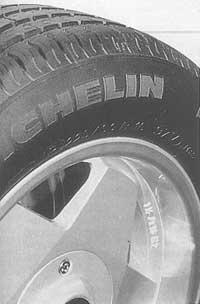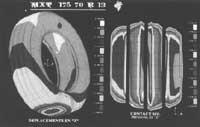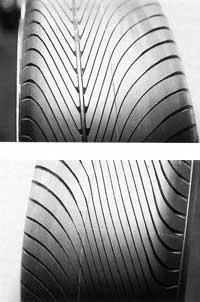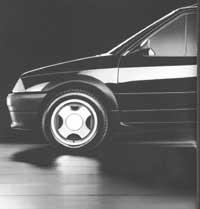Tire "green"
Two years ago the Michelin house announced a new product that was going to influence a major revolution from its radial tyre. When he said that the consumption of the vehicles was going to decrease considerably, people did not believe him too much. In 1991, U.S. motorists began picking up green tires, but in 1992 at the Detroit trade show the novelty was proven: The Michelin house will soon make all its tires, including truck tires.
Looking for the eco-friendly tyre

Engineers at the Ladoux research center, along with Clermont-Ferrand, had been looking for a more “environmentally friendly” tire than conventional one. The conventional car tyre consists of a bond of lime, hydrogen (in natural and synthetic rubbers), steel cables, fabrics, zinc, brass and, to a lesser extent, other chemicals, but also requires an energy of 27 liters of oil, which is the most important data.
The biodegradable tyre has also not been raised for safety reasons. From week to week no one would walk with a wheel that is degrading and eroding. The motorist would prefer the tire that does not wear or wear out, and it must be said that when the radial system was installed, the duration of the wheels increased by 25%. Today, the tyres travel an average of 50,000 kilometers and, of course, they will continue to increase, but you cannot get wheels that do not wear out.
Another advance would be to make a lighter tire. The radial system was reduced by 20% at the time and then another 10% has been won, but in the next ten years a maximum of 5% will be reduced. Therefore, from the weight point of view there are no high expectations.
Another solution could be the tyre retreading, as by placing the new rubber on the old wheel you save energy from 9 liters of oil.
Once all the calculations and tests were carried out, the researchers concluded that the savings in energy consumption should be produced during the operating stage of the tire, that is, knowing that 20% of the fuel is consumed by friction with the ground during the operation of the gear, that friction was what had to be lowered.
Trying to lower friction

Let's take an example to understand the friction the vehicle has with respect to the ground when it circulates. Imagine that we have a train and that it goes on rails. The resistance to rolling is low, less than if that train traveled on the asphalt. And if the train circulated on the sand, the consistency would be much greater.
Returning to the case of the car, on a hard and soft road, an overly inflated drive device by the wheels would be simple, but if the tire had less air than enough, it would cost you more. The soil or tire that can be deformed always offers greater resistance, and therefore it is important the tire, its degree of impregnation, the composition of the frame and rubber (having hard or soft rubber), the deformability, the design and the size (the diameter is inversely pro-portional to the resistance, since it is distributed in greater load surface). All these characteristics allow to calculate the resistance coefficient F and multiply the radio-damiento resistance by the supported load.
On the other hand, the resistance increases depending on the speed, since the deformation frequency of the tire is higher (it deforms more at a certain time when it works fast) and has influence on the feed resistance.
The researchers of the Michelin house, analyzing all the parameters of resistance to the advance of the vehicle, have managed to reduce 35% (even 50% in some urban vehicles), which means a reduction of the fuel consumption of 4.9%. In diagonal tires the average value of the F coefficient is 0.018 and in radial tires 0.014, but it also affects the state and composition of the road. Asphalt, for example, offers a resistance 1.2 times greater than plain concrete and ground 5 times greater when the road is flat and the tire is well inflated. In the best current radial tires the coefficient is 0.012, but in the “greens” it is 0.009 to 0.010. In the prototypes made for electric vehicles, it also descends to 0.006 or 0.007, due to its greater slowness.
Good performance and low resistance

Michelin's Ladoux labo fields for green tyre have made significant strides in the field of polymers. For a long time we have been working on the manufacture of low bearing resistance tires. It is enough to put in contact with the soil a rubber of great elasticity. These rubbers reproduce almost all the energy captured after the deforado. Some natural rubbers have this advantage, but unfortunately they do not “grab” the land on the wet road.
Other obstacles detected in other low-strength tires are excessive wear, vehicle handling difficulties, etc. In view of these circumstances, some houses have tried to reduce the resistance by applying normal pneomaticos to higher pressure, but we know that cattle in this aspect are lost in safety with less “grip” to the ground. However, the green tire has not only decreased resistance, but has not damaged safety, durability or any other performance.
Electric Car Tires
To indicate the road to a green tire, it is advisable to observe the development of tires for electric cars. The electric car itself has two major obstacles: low power and heavy batteries. Therefore, they require good aerodynamics, lightness and low rolling resistance. Hence the tyre houses have adopted new experimental models, such as Pirelli, Continental, Goodyear, etc. They have obtained coefficients of 0.006 or 0.007, but due to the weight of the batteries, the gun stick of the tires must be robust. The tyre called “Electron” by Michelin, for example, can carry a load that the conventional ones acquire to a width of 235 mm thanks to its special structure and a pressure of 3.5 bar.
Another peculiarity of electric car tires is its profile. Speeds are low, so the risk of wet road sliding is also minimal. Therefore, the canals that the wheel has to empty the water are hardly necessary and have a special “sculpture”. All the sculptures have curved and similar shapes, since all the houses have obtained similar results to achieve a low resistance in the sign made by computer. However, Michelin also has his secret in the confusion of the gums to have a better coefficient than the others.

Michelin green tires are like normal tires externally. Only the brand of where and when it has been manufactured can report that it is a green tire and Michelin has reason to commercialize green pneumatics semantically. Because in order for its production to go 100% “green” it has to change the factories it has now. It is true that there are no big differences in the frame, but it is necessary to introduce changes in the manufacturing system and for this it takes time. The new type of frame and “labor” lashing rubber is not prepared and vulcanized as in conventional tires.
Green tires will be 10% more expensive than conventional tires, but this cost difference will be amortized by the motorist at 11,000 km. It is true that this new tyre announced by Michelin will be copied by other houses. They say contestants know the composition of the new rubber, but it will take more than three years to make it.
Buletina
Bidali zure helbide elektronikoa eta jaso asteroko buletina zure sarrera-ontzian











